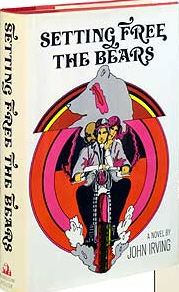Setting Free the Bears
 First edition | |
| Author | John Irving |
|---|---|
| Language | English |
| Publisher | Random House |
Publication date | 1968 |
| Publication place | United States |
| Media type | Print (hardback & paperback) |
| ISBN | 0-345-21812-4 (hardback edition) |
| Followed by | The Water-Method Man |
- This is about the novel; for the organization, see Free the Bears Fund.
Setting Free the Bears is the first novel by American author John Irving, published in 1968 by Random House.
Irving studied at the Institute of European Studies in Vienna in 1963 and Bears was written between 1965 and 1967 based largely on Irving's understanding of the city and its rebellious youth of the 1960s. The original manuscript for the book was submitted as his Masters thesis at the University of Iowa’s Writer's Workshop in 1967, and was later expanded and revised to its published version.
Bears is widely criticized as disjointed and naïve but in retrospect is deemed to have all the elements that have made Irving one of the most successful American authors of the day. These include a Dickensian narrative style, an inclination for the eccentric, unexpected violence, and a tendency to include thinly disguised biographical details in his work.
Plot summary
The book's central plot concerns a plan to liberate all the animals from the Vienna Zoo, as happened just after the conclusion of World War II. Irving's two protagonists—Graff, a young Austrian college student, and Siggy, an eccentric motorcycle mechanic-cum-philosopher—meet and embark on an adventure-filled motorcycle tour of Austria before the novel's climax: "the great zoo bust".
Towards the middle of the book the two protagonists go their separate ways and a large section of the novel is given over to “The Notebook”—a chronicle of the Siggy character’s family from pre-World War II, through the occupation of the Soviets, to the late 1960s. Siggy is killed in a motorcycle accident, the grief-stricken Graff then continues with their plan to free the inhabitants of the Vienna Zoo with Siggy's voice echoing in his head. This ends in catastrophic results.
